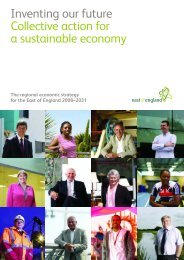Core Strategy Preferred Options document - Amazon Web Services
Core Strategy Preferred Options document - Amazon Web Services
Core Strategy Preferred Options document - Amazon Web Services
You also want an ePaper? Increase the reach of your titles
YUMPU automatically turns print PDFs into web optimized ePapers that Google loves.
Strategies, Activities and Actions – The Green Belt<br />
The Green Belt<br />
Protection of the Green Belt<br />
The District is predominantly Green Belt. National policy on the Green<br />
Belt is contained within Planning Policy Guidance Note 2 – Green Belts<br />
(PPG2). This states that the five purposes of including land within the<br />
Green Belt are as follows:<br />
• To check the unrestricted sprawl of large built-up areas;<br />
• To prevent neighbouring towns from merging into one another;<br />
• To assist in safeguarding the countryside from encroachment;<br />
• To preserve the setting and special character of historic towns;<br />
and<br />
• To assist in urban regeneration, by encouraging the recycling of<br />
derelict and other urban land.<br />
PPG2 also states that development should not be permitted in the Green<br />
Belt unless it is for any of the following purposes:<br />
• Agriculture and Forestry (unless Permitted Development Rights<br />
withdrawn);<br />
• Essential facilities for outdoor sport and outdoor recreation, for<br />
cemeteries, and for other uses of land which preserve the<br />
openness of the Green Belt and which do not conflict with the<br />
purposes of including land in it;<br />
• Limited extension, alteration or replacement of existing dwellings;<br />
• Limited infilling in existing villages, and limited affordable housing<br />
for local community needs under development plan policies<br />
according with PPS3; and<br />
• Limited infilling or redevelopment of major existing developed sites<br />
identified in adopted local plans (see Annex C of PPG2 for further<br />
details).<br />
The application of Green Belt policy has helped protect the historic fabric<br />
of the District; prevent encroachment of development into the<br />
countryside; protect natural features, flora, fauna and their habitats; and<br />
safeguard the countryside to provide recreational opportunities.<br />
We recognise that diverting development and population growth away<br />
from rural areas to existing urban areas can also assist in achieving<br />
sustainability objectives.<br />
We will continue to apply a restrictive suite of policies to preserve the<br />
character of its countryside. However, a small proportion of the District’s<br />
land that is currently allocated as Green Belt will have to have its<br />
designation reviewed due to the requirements to develop additional<br />
housing and employment, together with the limited opportunity to<br />
accommodate development outside of the Green Belt, as identified in our<br />
2007 Urban Capacity Study.<br />
41<br />
The Vision<br />
One of our key<br />
objectives, in line with<br />
the Vision, is to ‘define<br />
and protect the inner<br />
and outer boundaries<br />
of the Metropolitan<br />
Green Belt, the<br />
undeveloped coast<br />
and areas of<br />
ecological interest by<br />
directing development<br />
towards the District’s<br />
established<br />
settlements’.<br />
The Vision: By<br />
2017…<br />
Green tourism<br />
initiatives have been<br />
developed which<br />
provide sustainable<br />
opportunities for rural<br />
businesses whilst<br />
maintaining a high<br />
quality environment.<br />
Rural diversification<br />
has seen a number of<br />
bed and breakfasts<br />
and hotels appear,<br />
facilitating stays in the<br />
countryside for visitors<br />
to the area.
















